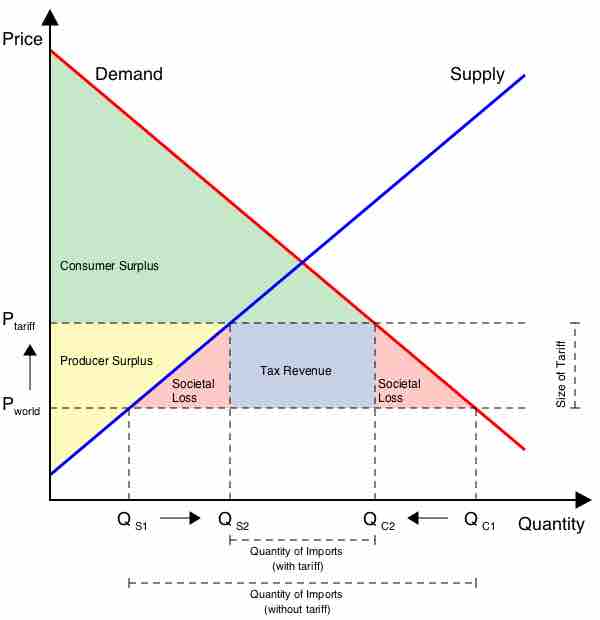Free trade is a policy by which a government does not discriminate against imports or interfere with exports by applying tariffs (to imports), subsidies (to exports), or quotas. According to the law of comparative advantage, the policy permits trading partners mutual gains from trade of goods and services.
Government Barriers to Free Trade
There are a number of barriers to free trade that governments can mitigate, most importantly, tariffs (government imposed import taxes) and quotas (government imposed limits on the quantity of a good that can be imported). Tariffs and quotas are explicit government policies that are designed to protect domestic producers, even if they are not the most efficient producers .

Loss Due to Tariffs
There are a number of reasons why governments place tariffs or other barriers to free trade, but they necessarily reduce overall societal welfare. Governments can promote free trade and impact economic growth.
In addition to tariffs and quotas, there are a number of other barriers to free trade that countries use. Broadly, they are categorized as non-tariff barriers (NTBs). NTBs come in a variety of forms. One example of an NTB are product standard requirements. A country can set high quality standards for a product, knowing that not all foreign producers will be able to meet the standard. Another way that countries can implement NTBs is through customs procedures. Countries can force foreign exporters to fill out arduous paperwork over the course of months, and perhaps in a language the foreign producer does not speak. NTBs act just like tariffs and quotas in that they are barriers to free trade.
Government Promotion of Free Trade
Countries that recognize the benefits for growth from promoting free trade can take unilateral, bilateral, or multilateral action to reduce some of these barriers to trade.
Unilateral promotion of free trade is when a country decides to reduce its own trade barriers without any promise of action from its trading partners. This would lead to a reduction in import prices, but could be unpopular with domestic industries who are not afforded lower barriers in the countries with which they wish to trade.
Bilateral promotion of free trade is when two countries come to an agreement to reduce barriers together. This solves the problem of one country giving the benefit of reduced barriers to foreign exporters without any promise of similar benefits in return.
Multilateral promotion of free trade is when a group of countries agree to reduce their barriers together. Examples of multilateral promotion of free trade are trade agreements such as the North American Free Trade Agreement (NAFTA) in which the US, Mexico, and Canada agreed to allow free trade among one another.
Reducing barriers to free trade may be politically difficult, but due to the law of comparative advantage, will allow for increased overall surplus for each trading partner in the long run.